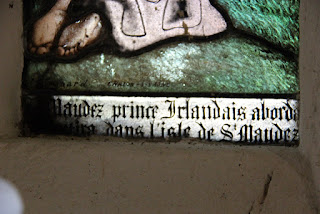Students often ask me what is there to see and do in Brittany when not cooking in the kitchen. I usually refer to the astonishing beauty of the Briton coastline, or the medieval splendour of ancient towns and villages but rarely do I think of churches! Well that is a big mistake as I recently found out by my trip to the little 13th century Chapel of Kermaria An Isquit located just six kilometres from the town of Plouha in northern Brittany and only about an hour's drive from our cooking school. This little chapel deserves to be nominated for listing as a UNESCO world heritage site for its breathtaking frescoes of the Dance of Death visible along both sides of the nave and painted between 1483 and 1501.

The chapel is thought to be the work of Henry of Avaugour and other Lords of Goelo who wanted to show their gratitude to the Virgin Mary after returning home safely from their crusades in the Holy Lands in 1240. The first building dates from the 13th century includes the first four spans of the nave and the side aisle. It was promoted by the monks of the Abbey of Beauport and expanded as it became an important place of pilgrimage with further expansion in the 15th and 17th centuries. The visitor enters through a Gothic porch where amazing original wooden sculptures of the 12 apostles stand either side as you enter the chapel. Sadly one statute (of St Luke) was stolen from the collection in 1907 and has never been found. More worrying is that there are signs of woodworm in some of the sculptures so they do need proper maintenance and security if they are to last for future generations to enjoy.


However it is the Danse Macabre or Dance of Death which draws most visitors to the chapel. This is an extraordinary collection of frescoes which were only discovered in the middle of the 19th century by Charles de Taillard one of the original descendants of the lords who owned Kermaria since the 16th century! In fact it was the discovery of the frescoes in 1857 which saved the chapel from demolition. These frescoes were initially inspired by the Dance of Death painted in Paris in 1424 under the arcades of the cloister of the grave of the Satin Innocents, reproductions of which were widely circulated throughout Europe.
The thirty figures which are holding hands represent living persons of all ages and all classes but separated by emaciated cadavers who put a rhythm into the dance. Here is some further information:
There is so much more to see here that I suggest you visit at 3pm in the afternoon when you can avail of a very knowledgeable guide to show you around (the chapel is open from 10.30am to 12 noon and 3pm to 5pm each day).
Initially I assumed this little fellow was St George with his dragon but I have been reliably informed and that he is St Michel et le dragon! You can also see him at Le Mont St Michel which is another great trip to make one day!
I was intrigued to note the commemoration to St Maudez with the tiny Irish harp in the little stained glass window on the left side of the alter. This Irish prince had visited Brittany in the 6th century and gives his name to both the island of Maudez (near Ile de Brehat) where he built a monastery and the commune of St. Maudez in Cotes d'Armor.














No comments:
Post a Comment